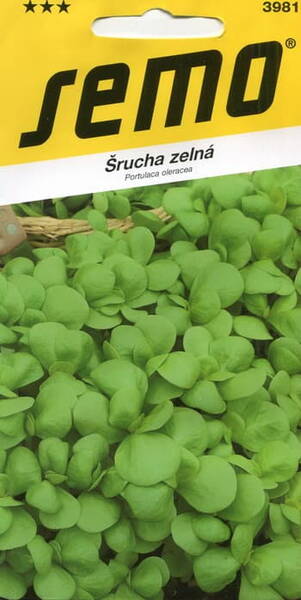An early alternative to spinach. Suitable for growing on a windowsill: the first harvest in 20-30 days.
Annual early-ripening vegetable plant with juicy, fleshy stems and leaves. A bed with this plant resembles thickets of dense, beautiful glossy greenery. Greens are rich in organic acids and contain carotene and vitamins. It is especially useful for people suffering from diabetes and liver and kidney diseases.
Leaves and upper parts of young shoots are used for food in salads, as well as in soups and sauces. Pickled purslane is an excellent seasoning for meat dishes.
1,0 g = 1900-2000 seeds.
Agricultural technology.
Sowing: May-June in well-warmed soil (open ground) or April for seedlings to a depth of no more than 0.5 cm. The distance between rows is 50-60 cm. In the phase of 1-2 true leaves, the plants are thinned out, maintaining a distance between plants of 10- 15 cm.
The culture is thermophilic (does not tolerate even the slightest frost) and prefers a sunny location and well-cultivated, fertile and moist soils.
20-30 days after sowing, the first cut is carried out (it is cut almost completely). Then the cut is repeated as needed (up to the beginning of flowering). Usually, 2-3 cuts are made during the growing season.
* Purslane has been known since antiquity. From Egypt, Italy and Greece came to other countries of southern Europe. It is loved in the south, and to the north, it began to spread with the advent of inexpensive covering material.
Small round-oval thickened leaves, juicy and crispy, slightly sour, good for fresh salads, they are nice to just chew in the heat. Fleshy (up to 1.5 cm) shoots are stewed, marinated, salted and served as a side dish for meat. The leaves are green, sometimes with an anthocyanin edging, the same shade is found in a creeping stem that branches from the base, which is why the purslane sown in rows quickly forms a solid mat about 20 cm high on the bed. The flowers are yellow. Small dark grey or black seeds are sown to a depth of 0.5–1 cm with a distance between rows of 40–50 cm in warm (+12+15°C) soil; germinate in 10-14 days. The leaves usually begin to tear after two weeks - simultaneously with the thinning of the plants by 10–15 cm. The shoots cut off in the summer at a height of 3–4 cm from the ground grow back in two to three weeks. This culture does not tolerate waterlogging of roots and tops, and any soil suits it, but more powerful bushes with large leaves develop on fertile and loose ones. Purslane is often used as a compactor, for example, for cabbage and tomatoes.
Eng.: Green-Leaved Purslane, Kitchen-Garden Purslane.
For therapeutic purposes, grass and seeds of garden purslane are used.
In the leaves - carotene, organic acids, sugar, glycosides, alkaloids and proteins.
The seeds contain fatty oil.
In scientific medicine, seeds and grass are used as an anthelmintic.
In folk medicine, fresh juice is used in the treatment of eye diseases. An infusion of the herb is recommended as a diuretic in diseases of the liver, kidneys and dysentery and as an antitoxic agent. Outwardly, fresh juice or infusion of purslane is used as a wound healing agent, as well as for trichomonas colpitis.
• 1 tbsp. a spoonful of fresh chopped herbs for 1 cup of boiling water, leave for 1-2 hours and strain.
Take 2-3 tbsp. spoon before meals 4 times a day for impotence.
• Grass juice.
Take 1 tbsp. spoon 3 times a day as a choleretic and cooling, anti-inflammatory in diseases of the kidneys, liver and bladder.











